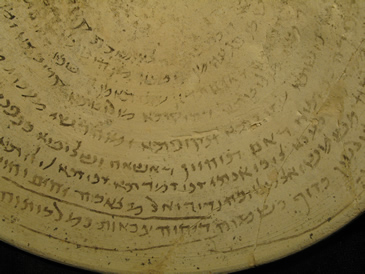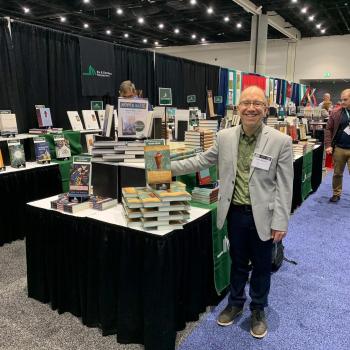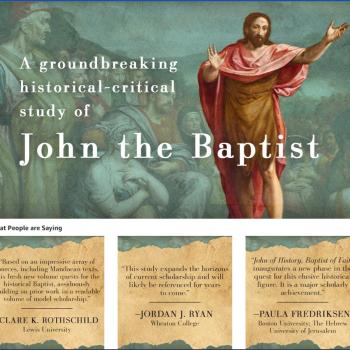For those interested in Judaism, Mandaeism, Late Antiquity, ancient magic, Aramaic, and any number of other topics, there are two sessions at AAR this year that you ought not to miss. One is the Traditions of Eastern Late Antiquity session, about which I’ll include details further below. But the other is a session which will feature some actual magic bowls on display. I’m concerned that some might miss this rather unique opportunity, and so I thought I should highlight it here on my blog. Here are the details:
A22-401
Arts Series
Theme: Arti-Facts/Divorcing the Demons: A Collaborative Gallery Installation and Storytelling Performance with Babylonian Incantation Bowls
Sunday – 8:00 PM-9:30 PM
Marriott-Imperial A (Marquis Level)
During Late Antiquity in Babylonia, under Zoroastrian-Sassanian rule, a variety of different faith communities shared a ritual to expel demons from their domestic environments. Although there are few clues as to the actual process, inscribed earthenware vessels were deliberately buried in thresholds, interior rooms, and cemeteries from the 5th-late 7th Centuries CE. Over 2000 examples of ceramic vessels with texts (almost all bowls, with an amphora and a goblet) have been unearthed since the late 19th Century. Thus far, only a few hundred have been translated and published.
The predominant script used on these “magic” bowls is Judeo-Aramaic, used mostly by the literate Jewish community of the time. Other scripts are also in evidence: Mandaic from the religious group, Mandaeans, and a few examples in Syriac from the Christian community. Also found were “fake” bowls that have scribbles instead of actual text perhaps indicating illiterate magicians and/or illiterate clients!
Once all of these groups lived together and shared a ritual that might just help today: expelling the demons that plague us all.
The bowl texts name specific clients, representing all of the religious groups, seeking respite from discord. In many cases, the inscriptions address specific demons suspected of causing strife The singular bowls were then buried inverted. There is another category of bowls that seems somewhat distinct. Two bowls of the same diameter and rounded on the bottoms, with similar texts spiraling inside each of the pair, were fixed together with bitumen (asphalt) and cord. The texts of these are curses requesting that the evil acts return upon the perpetrator. Dan Levene, a prominent British scholar working with these artifacts, hypothesizes that these are not aimed at demons, but instead at a particular human who was manipulating the evil actions at the client.
Past and present, human communities share similar anxieties. The list might include disease, dangers in childbirth, loss of livelihood, familial discord, war, famine. One might add arrogance, violence, senseless hatred, hypocrisy, stupidity, and malice to our contemporary anxieties. As artists and scholars, we view the ancient act of sharing a ritual across faith traditions as one worth reconsidering for the present. And so we present this exhibition and storytelling performance as a beginning of this reconsideration.
Panelists:
Laurel Robinson, Georgia Southwestern State University
Keaton Wynn, Georgia Southwestern State University
Daniel Rosenberg, Chicago, IL
And here are the details about the TELA (Traditions of Eastern Late Antiquity) session:
A22-233Traditions of Eastern Late Antiquity GroupTheme: Bordering Others: Examining Religious Community in Eastern Late AntiquityJames McGrath, Butler University, Presiding
Sunday – 1:00 PM-2:30 PMHilton-211 (Level 2)This session provides a place for a variety of papers and scholars to meet who are interested in the diversity of religious community in the Late Ancient East (Eastern Roman Empire through China).
Fixing Ritual to Fix Community: Using Orthopraxy to Define “True” Mandaeism“…And No Trace Left of Their Bones”: Conversion and Continuity in Early Armenian ChristianitySeeing the Other in Sasanian BabyloniaDon’t Bowl Me Over: An Examination of Aramaic Curse Bowls and the Suba Cave Inscriptions
The Word “Tajik”/”Daqing” in Chinese Sources and What It Tells Us about the Islamicization of Central Asia during the Early Abbasid Caliphate
A20-200Traditions of Eastern Late Antiquity Group and IQSA Qur’an and Late Antiquity GroupTheme: Towards a “Long Late Antiquity”: Continuities from the Pre-Islamic to the Islamic EraMichael Pregill, Boston University, Presiding
Friday – 1:00 PM-3:30 PMMarriott-M104 (Marquis Level)
Law and Tradition in the Long Seventh Century (570-705): Between Qur’an and Church CanonThe Pre-Islamic Image of the Word “Saracen” and Its Implications for Early Christian and Islamic Interactions“Why Do the Rabbis and Religious Authorities Not Forbid Them from Uttering Sinful Words?”: Qur’anic and Late Antique Attitudes towards Religious ScholarsIs Ghulat Religion Islamic Gnosticism? The Shi’ite “Extremists” of Early Islamic Iraq
Is Ghulat Religion Islamic Gnosticism? Syro-Mesopotamian Gnostic Traditions
A23-237Traditions of Eastern Late Antiquity Group and SBL Religious World of Late Antiquity GroupTheme: “Christianization” and “Islamization”: Terminologies, Categories, Case StudiesWendy Mayer, Australian Catholic University, Presiding
Monday – 1:00 PM-3:30 PMMarriott-A702 (Atrium Level)Nathan Schumer, Columbia University
Disaster and Christianization: The Earthquake of 363 CE and the Christianization of the Cities of Roman Palestine“Sprinkle the Place with This Water”: Christianization and Islamification of Religious Space in Late AntiquityBy the World Forgot: Sabbatians and the Manipulation of Memory in Fifth-Century ConstantinopleForming a Muslim Understanding of Celibacy: The Case of al-Junayd al-Baghdadi
Living and Dying a Christian under Islam: Martyrologies and the Islamification of Late Antique Palestine













